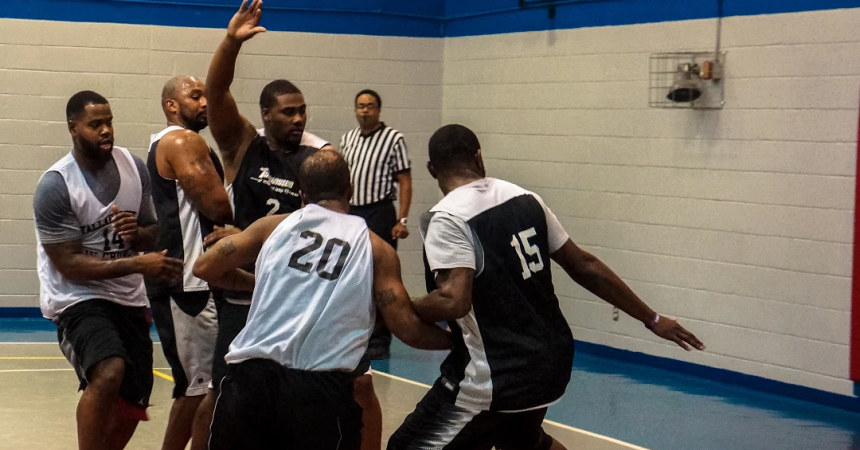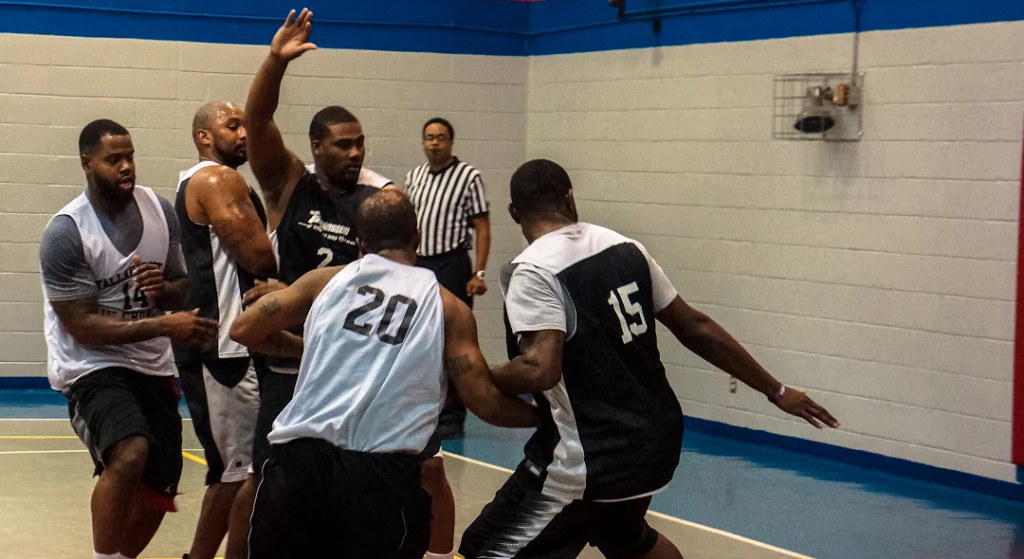
Players find city league a place for reprieve, develop skills

Tallahassee SDA Church battles Tallahassee DCJ for the ball as the game comes to a close. Photo by Elegance Davis
By Samantha Joseph
Outlook writer
A few nights each week, Marcus Dupree runs the hardwood floor at Walker/Ford Community Center. He tries the 3-point shot, a jumper here and there as well as a layup whenever he sees an opportunity.
It’s his reprieve and he looks forward to the nights when he and other 30-something men go against players their age or even some who could be as many as 10 years their juniors. Occasionally a few 40-something guys show up on one of the many teams that play in a winter league sanctioned by Tallahassee Park, Recreation and Neighborhood Affairs.
The league has been ongoing for more than two decades, and while the competitiveness has arguably dropped off a bit, players like Dupree look forward to the challenge of beating another man to the hoop.
He is entering his 10th season in the league.
“It’s the competitive nature,” Dupree said, explaining why he keeps coming. “The drive and being a part of the city league is my version of the NBA. I didn’t get to play two or four years in college like most guys and I didn’t get the opportunity to play overseas (so) I’m going to keep doing it until I can’t walk.”
Playing isn’t cheap for the teams. They get into the league on a $525 fee and teams that miss the sign-up deadline are charged an additional $10.
While players aren’t restricted to playing in identical uniforms, the league is organized to keep parity as teams are classified in divisions by their competitiveness. Additionally, the rules are aimed at keeping it that way and while players can transfer from one team to another, they can’t jump classification.
The league began its 2017 season this past week and already there are signs of an obvious brotherhood among the players – even with their opponents.
Their camaraderie might even include a little jeering, as was the case during one of the opening night matchups. One player heckled an opponent as he stepped to the free-throw line to attempt a foul shot.
“Here we go; nothing but love here,” a voice from the opposing bench shouted across the court.
The scene is one that is likely to play out during the –two-month season for the entertainment of their fans. Players often bring girlfriends and wives. In some cases, their children are there, too.
Players like 30-year-old Joseph Howell take to the hardwood to stay in shape. A former player at Central Methodist University who said he spent time in the European league, he is hoping for one more shot.
“I have been playing basketball for a long time and that’s why I have a determination and desire,” Howell said. “I do love the game and will keep playing until I can’t anymore.”
For others, especially the younger players, the league is a diversion. And still players like Dupree hopes to sharpen their skills to pass on to the next generation.
“When I’m done playing, I want to offer something that will keep kids and adolescents out of trouble and keep them involved,” he said. “I know for a lot of guys that play this is their outlet to keep them away from trouble. The more we create for people to do the less violence and less trouble we’ll see, hopefully.”
That has been proven. Back in the early 1980s when Greg Grady ran a league for the city at Dade Street, the center became a gathering place for the French Town community a few nights each week. Talent in the league was so deep that it earned a spot among the most-competitive summer leagues that were ranked by USA-Today.
Crime in the community was lower, too, Grady recalled.
“I found out that sports have a universal language that reaches young men and if you can reach them you can teach them; not at just the sport but in life,” said Grady, former director of the Lawrence-Gregory Community center. “You know, how to be dedicated, cultivate what it is to be a man, how to be productive, how to find jobs and how to strategize for the future.”







